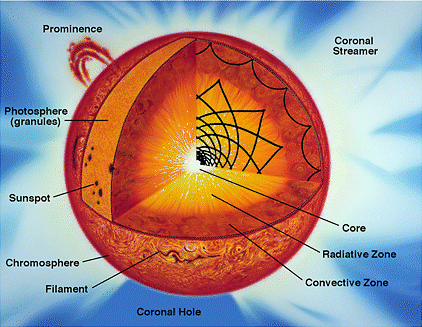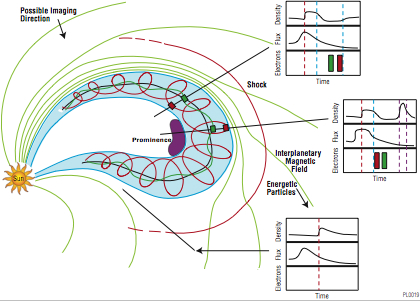Space Weather
Living With a Star Guide to Space Weather
Just as cities can be buffeted by winds, flood, and rain, so too the
entire Earth is bathed in a million-mile-per-hour wind of charged
particles from the Sun that affects many spacecraft and terrestrial
systems such as communication and electrical power networks.
Understanding the solar wind, its magnetic field, and the energetic
particles that flow through it from the Sun and our galaxy will also be
crucial for human exploration in space. The state, dynamics, and
effects on the Earth and human concerns of the particles and fields
outside the Earth's immediate environment are what is now termed "space
weather." This page provides a number of links to images, movies, and
graphs that will give you a view of the current weather in space; many
also provide data from earlier observations. Two good overview sites are
SpaceWeather.com and
NOAA/SEC Today's Space Weather.
If you want to go directly to links to answer
specific space weather questions, click
here, or read on for a quick overview.
The Sun and Solar Wind
 Space weather begins below the surface of the Sun where the turbulent
overturning of the outer layer of the Sun (the convection zone)
continually drives magnetic fields through the solar surface
(photosphere). These magnetic fields provide the dominant energy above
the photosphere, especially in the very hot (millions of Kelvins) corona
that starts after a transition region within a very small distance of
the photosphere. The release of magnetic energy, in not fully
understood ways, leads to the rapid energization of charged particles
through the flaring of
active regions and the release of massive loops
of field and plasma known as Coronal Mass Ejections (CMEs).
Space weather begins below the surface of the Sun where the turbulent
overturning of the outer layer of the Sun (the convection zone)
continually drives magnetic fields through the solar surface
(photosphere). These magnetic fields provide the dominant energy above
the photosphere, especially in the very hot (millions of Kelvins) corona
that starts after a transition region within a very small distance of
the photosphere. The release of magnetic energy, in not fully
understood ways, leads to the rapid energization of charged particles
through the flaring of
active regions and the release of massive loops
of field and plasma known as Coronal Mass Ejections (CMEs).
 The solar energy releases and their precursor regions are visible in
photographs of the Sun and its surrounding atmosphere. The flare
particles and associated X-rays move rapidly toward the Earth where they
are measured by orbiting spacecraft. The radiation comes straight to us
and the particles move along the spiraling interplanetary magnetic field
lines, arriving somewhat later. The CMEs, which may or may not have
associated flares, take one to four days to reach the Earth,
accelerating particles along the way, and causing the major "magnetic
storms" when they reach the Earth. Spacecraft orbiting outside of the
Earth's magnetic influence
measure the interplanetary fields before they
reach the Earth, giving an hour or so warning of the impending effects.
The solar energy releases and their precursor regions are visible in
photographs of the Sun and its surrounding atmosphere. The flare
particles and associated X-rays move rapidly toward the Earth where they
are measured by orbiting spacecraft. The radiation comes straight to us
and the particles move along the spiraling interplanetary magnetic field
lines, arriving somewhat later. The CMEs, which may or may not have
associated flares, take one to four days to reach the Earth,
accelerating particles along the way, and causing the major "magnetic
storms" when they reach the Earth. Spacecraft orbiting outside of the
Earth's magnetic influence
measure the interplanetary fields before they
reach the Earth, giving an hour or so warning of the impending effects.
In addition to these sporadic releases of energy, the Sun's atmosphere is continually
flowing outwards to form the solar wind, of which CMEs are only a part.
The solar wind consists of both charged particles and associated magnetic fields.
Areas in which the magnetic field open into the interplanetary medium are dark in X-ray and
many EUV images of the Sun are called coronal holes. Solar wind plasma from coronal holes
flows more quickly than plasma from other areas on the Sun, and the presence of
a hole near the sun's equator facing Earth can also lead to disturbances in Earth's magnetic field (the
"magnetosphere").
The Earth's Magnetic Field and Upper Atmosphere
The Earth's magnetosphere and ionosphere respond directly and indirectly
to solar radiation, and solar wind plasma, energetic particles, and
magnetic fields. On the sunlit side of the Earth, the enhanced
radiation associated with solar flares enhances ionospheric ionization
and can disrupt radio communication. If the Sun falls within the field
of view of a ground radar, solar radio waves can disrupt the radar's
operation. The Earth's magnetic field channels energetic particles into
the polar caps, where they can also enhance ionization and disrupt
communication. Southward solar wind magnetic fields enable widespread
entry of solar wind mass, energy, and momentum into the region of space
dominated by the Earth's magnetic field. The energy entering the dayside
magnetosphere is generally transferred to the nightside and stored
within the stretched magnetic field lines of the Earth's magnetotail.

This transfer of energy results in the antisunward motion of ionospheric plasma over
the Earth's polar caps. This flow can be observed directly by radars, or
inferred from ground magnetometer observations of ionospheric currents.
During quasi-periodic (~3 hours) substorms, field lines snap back into the
familiar dipolar (bar magnet) configuration, injecting copious fluxes of
newly energized ions and electrons into the Van Allen
radiation belts of the
inner magnetosphere. Some of the ions and electrons precipitate (stream
along) magnetic field lines into the Earth's atmosphere, where they create
beautiful (and as yet poorly understood) optical and ultraviolet displays of
aurorae in the high latitude nightside sky, as well as repeatable and
significant variations in the magnetic field strength and direction observed
on the ground at high latitudes. During sequences of substorms, known as geomagnetic storms,
radiation levels within the magnetosphere can rise by many orders of
magnitude. The radiation is dangerous for astronauts and spacecraft. The
injected ions and electrons drift in opposite directions around the Earth,
resulting in a ring current that depresses and disturbs magnetic field
strengths and directions over the entire surface of the Earth. During large
storms, the Earth's field may be so weakened that aurora can penetrate down
to latitudes over the continental United States.
Links:
LWS Space Weather Data FAQ
Space Weather Primer,
an overview of the affects of space weather from the NOAA/Space Envioronment Center.
A guide to using online data for space weather forecasting
from the Royal Observatory of Belgium.
Draft web site 6/18/04, tak
 The solar energy releases and their precursor regions are visible in
photographs of the Sun and its surrounding atmosphere. The flare
particles and associated X-rays move rapidly toward the Earth where they
are measured by orbiting spacecraft. The radiation comes straight to us
and the particles move along the spiraling interplanetary magnetic field
lines, arriving somewhat later. The CMEs, which may or may not have
associated flares, take one to four days to reach the Earth,
accelerating particles along the way, and causing the major "magnetic
storms" when they reach the Earth. Spacecraft orbiting outside of the
Earth's magnetic influence
measure the interplanetary fields before they
reach the Earth, giving an hour or so warning of the impending effects.
The solar energy releases and their precursor regions are visible in
photographs of the Sun and its surrounding atmosphere. The flare
particles and associated X-rays move rapidly toward the Earth where they
are measured by orbiting spacecraft. The radiation comes straight to us
and the particles move along the spiraling interplanetary magnetic field
lines, arriving somewhat later. The CMEs, which may or may not have
associated flares, take one to four days to reach the Earth,
accelerating particles along the way, and causing the major "magnetic
storms" when they reach the Earth. Spacecraft orbiting outside of the
Earth's magnetic influence
measure the interplanetary fields before they
reach the Earth, giving an hour or so warning of the impending effects.
 Space weather begins below the surface of the Sun where the turbulent
overturning of the outer layer of the Sun (the convection zone)
continually drives magnetic fields through the solar surface
(photosphere). These magnetic fields provide the dominant energy above
the photosphere, especially in the very hot (millions of Kelvins) corona
that starts after a transition region within a very small distance of
the photosphere. The release of magnetic energy, in not fully
understood ways, leads to the rapid energization of charged particles
through the flaring of
active regions and the release of massive loops
of field and plasma known as Coronal Mass Ejections (CMEs).
Space weather begins below the surface of the Sun where the turbulent
overturning of the outer layer of the Sun (the convection zone)
continually drives magnetic fields through the solar surface
(photosphere). These magnetic fields provide the dominant energy above
the photosphere, especially in the very hot (millions of Kelvins) corona
that starts after a transition region within a very small distance of
the photosphere. The release of magnetic energy, in not fully
understood ways, leads to the rapid energization of charged particles
through the flaring of
active regions and the release of massive loops
of field and plasma known as Coronal Mass Ejections (CMEs).
